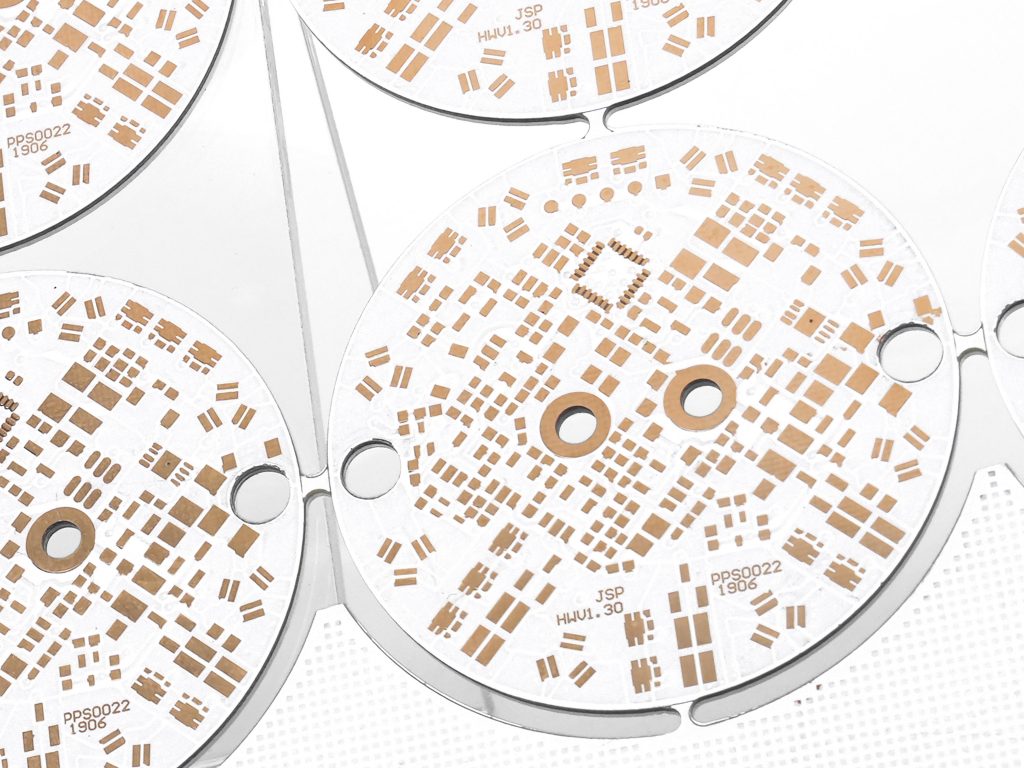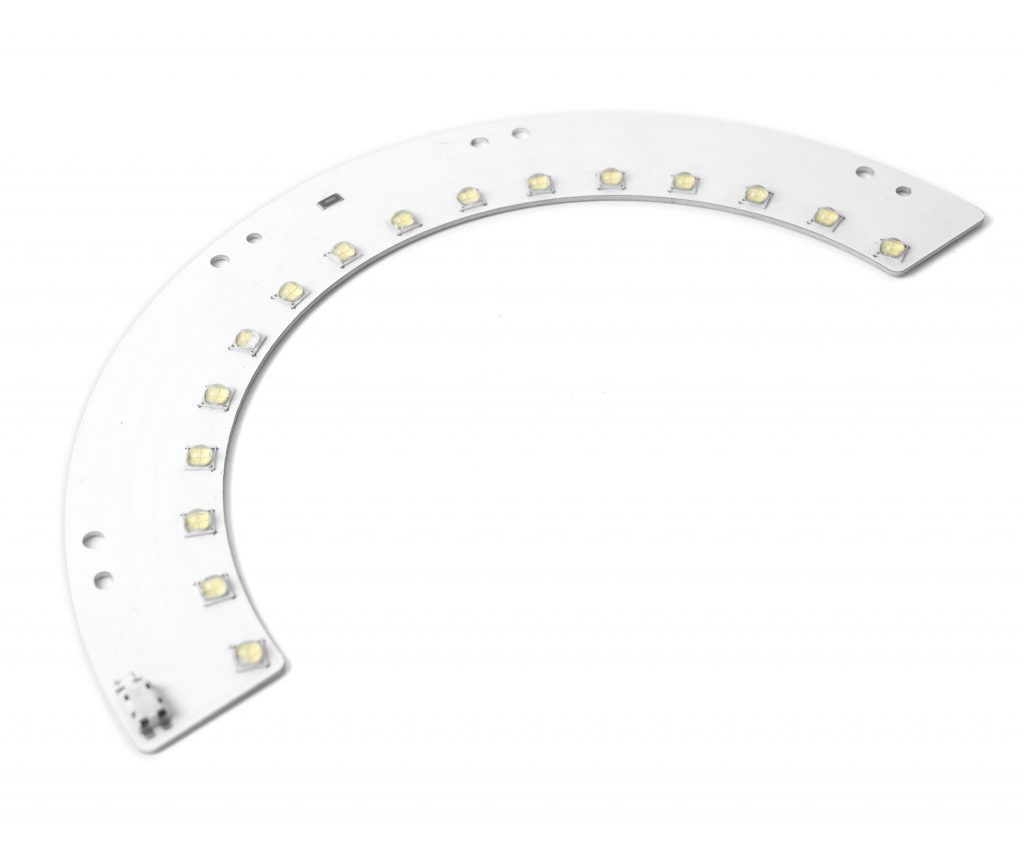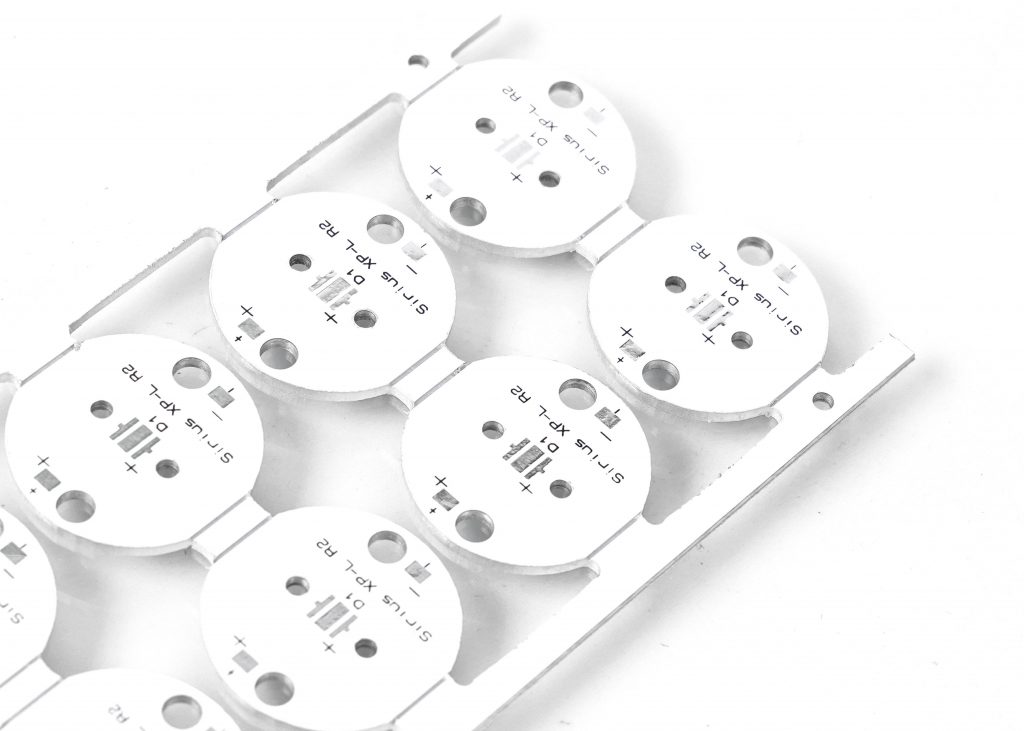Aluminum LED PCB board are almost everywhere in our lives. LED lights have become more popular than other lights in the field of lighting. LED PCBs usually use aluminum or metal core as substrates. Aluminum can dissipate heat effectively and there is no need to use a heat sink, so the PCB can effectively dissipate a lot of heat without problems.
What is aluminum led pcb board?
Aluminum LED PCB board is a special printed circuit board that is mainly used for LED lighting and other equipment that requires efficient heat dissipation. Unlike traditional FR-4 fiberglass boards, aluminum LED PCB boards use aluminum alloy as the substrate and have better thermal conductivity. This type of board usually consists of a three-layer structure: circuit layer (copper foil layer), insulation layer, and metal base layer.

The characteristic of aluminum LED PCB board is that it uses aluminum alloy material, which has excellent thermal conductivity and can quickly dissipate the heat generated when the LED is working. Compared with traditional FR-4 fiberglass boards, aluminum substrates have higher thermal conductivity and can carry higher currents, which are suitable for applications that require high power output.
In addition, aluminum substrates also have good electrical insulation and machining properties, which makes them also have a place in high-end applications.
In terms of application, aluminum LED PCB boards are mainly used in products such as LED lighting equipment and solar street lights that require efficient heat dissipation. Due to its excellent thermal conductivity and cost-effectiveness, aluminum substrates have quickly become the preferred material in these fields.
Why choose aluminum led pcb board?
The main reason for choosing aluminum-based PCB boards is that they are due to their excellent thermal conductivity and light and high-strength characteristics, which can effectively reduce the operating temperature of LED lights and improve their stability and reliability.
The advantages of aluminum-based PCB boards include:
- Excellent thermal conductivity â: The aluminum substrate uses metal aluminum as the substrate, which has excellent thermal conductivity, can effectively conduct the heat generated by the LED when it is working, reduce the module operating temperature, extend the service life, and improve the power density and reliability. â

- Lightweight and high strength â: The aluminum substrate material is light and has high strength, which is suitable for various complex environments and high-strength application scenarios â.
- âElectromagnetic shielding performanceâ: Aluminum substrate has good electromagnetic shielding performance, which can effectively reduce electromagnetic interference and improve the signal transmission quality of electronic equipmentâ.
- âHigh degree of customizationâ: Aluminum substrate can be customized according to customer needs to meet the specific needs of different application scenariosâ.
Disadvantages of aluminum led pcb board
The main disadvantages of aluminum LED PCB board include high cost, difficult process, electrical strength and voltage resistance problems. â
First, the cost of aluminum LED PCB board is high. Compared with other materials, the price of aluminum substrate accounts for more than 30% of the product price, which increases the cost of the product to a certain extentâ.
Secondly, aluminum LED PCB board has certain difficulties in process. The current mainstream products are mainly single-sided boards, and the process of making double-sided boards is more difficultâ.
In addition, aluminum LED PCB boards are prone to problems in electrical strength and voltage resistance. Due to the characteristics of the material itself, the manufactured products may not meet the standards in terms of electrical strength and voltage resistanceâ.
What are the types of LED PCB boards?
LED PCB boards are printed circuit boards for mounting LEDs. Their substrate materials mainly determine the thermal conductivity of LED PCBs. According to the different heat dissipation performance, LED PCB boards can be divided into 6 types.
- Aluminum LED PCB: Aluminum LED PCB is the most common and cost-effective printed circuit board for LED lights, such as LED plant growth lights.

- Copper-based LED PCB: Copper-based LED PCB is used for high-power LED lights, such as car headlights. The structure of ordinary copper-based LED PCB is the same as that of aluminum LED PCB, but the thermal conductivity is several times higher than that of aluminum LED PCB.
- FR-4 LED PCB: If the LED light is used as daily household lighting and does not require much printed circuit board heat dissipation, FR-4 LED PCB can be a cost-effective printed circuit board choice. The price of FR-4 LED PCB is lower than other types of circuit boards.
- Ceramic LED PCB: High-power LED lights, especially photography and pool lights, use ceramic LED PCB. Ceramic LED PCBs include aluminum nitride (AlN) PCBs, aluminum oxide (alumina) PCBs, boron oxide (BeO) PCBs, and silicon nitride (SiâNâ) PCBs. The most common ceramic LED PCBs are AlN PCBs and alumina PCBs.
- Hybrid substrate LED PCBs: The substrate materials of high-power LED PCBs can be mixed. Hybrid LED PCBs can have two or three substrate materials. And the different substrate materials are connected by phase change, that is, they are combined into a whole.
- Flexible LED PCBs: Flexible PCBs with polyimide or polyester substrates are used for flexible LED light strips. Flexible LED PCBs can be used for mask lights, miner headlamps, and indoor/outdoor decorative light strips.
What is a SMD LED PCB board?
SMD LED PCBs are printed circuit boards for surface mounted LEDs (Surface Mounted Devices). â SMD LED PCBs are LED chips packaged into lamp beads, which are then soldered on PCBs to make LED modules with different spacings. In this packaging method, each lamp bead is an independent point light source, which has the advantages of small size, large scattering angle, good luminous uniformity and high reliability.
The characteristics of SMD LED PCB board include:
- 1. Principle of luminescence: When the current passes through the compound semiconductor, the electrons and holes combine to release energy and emit light, which belongs to cold luminescence, and the life span is about 50~100 times longer than that of tungsten filament bulbs, up to 100,000 hours.
- 2. Fast response speed: The lighting response speed is faster than that of ordinary electric lights, about 3~400 nanoseconds.
- 3. Energy saving and high efficiency: The electro-optical conversion efficiency is high, the power consumption is small, and it saves about 1/3~1/20 of the energy compared with the light bulb.
- 4. Wide application: It is mainly used in lighting systems, decorations, electronic equipment indicators, backlights, displays and instruments.
How to make aluminum led pcb board?
LED circuit boards usually have good thermal conductivity, electrical insulation, and mechanical processing performance, and are mainly composed of metal-clad copper plates, conductive layers, and insulating layers.
The main manufacturing processes of LED PCB include:
- 1. Raw material cutting
- 2. Drilling
- 3. Image transmission
- 4. Etching
- 5. Screen printing
- 6. Solder mask
- 7. Surface treatment
- 8. V-shaped cutting
- 9. Testing
- 10. FQC and packaging
What do G, R, B and + mean on the LED PCB?
On the LED PCB, G, R, B and + represent the following meanings:
- G stands for ground: It is the zero potential reference point in the circuit, and the potential of all other circuits is measured relative to the ground. The ground plays the role of providing reference potential and preventing mutual interference between circuits in the circuit.
- R stands for red: In LED display screens, R usually refers to red light-emitting diodes, which are used to produce red light. Red light is part of the visible spectrum and is often used in color displays or lighting systems.
- B stands for blue: Also in LED display screens, B stands for blue light-emitting diodes, which are used to produce blue light. Blue light, together with red and green light, can synthesize various colors and is widely used in color display technology.
- + represents positive supply voltage: In the circuit, the + symbol usually represents the positive supply, that is, the power supply end that provides positive voltage. This is an important part of the power supply in the circuit to ensure the normal operation of electronic components.
In short, aluminum-based LED PCB boards occupy an important position in the electronics field with their excellent heat dissipation performance, reliable electrical performance and high mechanical strength. With the continuous advancement of technology, it will continue to bring more efficient solutions to many industries such as lighting, display screens, and automotive electronics.
Tags: Aluminum led, led pcb, PCB


